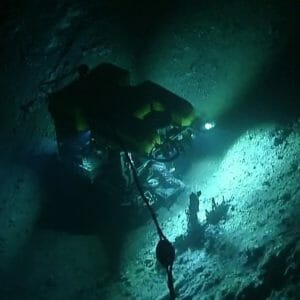
Scientists from Arizona State University, who are a part of the Systematic Underwater Biogeochemical Science and Exploration Analog (SUBSEA) program, have pioneered a new approach to the scientific process of geochemical exploration for our Earth and beyond.
Sustainability scientist Everett Shock of ASU’s School of Earth and Space Exploration and former ASU postdoctoral scholar Vincent Milesi worked with teams onboard the Ocean Exploration Trust’s (OET) Exploration Vessel Nautilus to use deep-sea exploration on Earth as an analog for hydrothermal systems on other ocean worlds.
In so doing, they designed and tested a new concept of operations that could help change the paradigm of planetary exploration. Their new approach is detailed in a recent article, Forward geochemical modeling as a guiding tool during exploration of Sea Cliff hydrothermal field, Gorda Ridge, published in the journal Planetary and Space Science. The abstract follows. Read the full story on ASU News.
Maximizing scientific return is critical to the success of space exploration. During the SUBSEA project, which explored the Sea Cliff vent site aboard the E/V Nautilus as an analog for hydrothermal systems on Ocean Worlds, we used forward geochemical modeling to guide decision-making during the process of exploration. Before the expedition, we performed 1670 reaction-path calculations to simulate water-rock interactions during hydrothermal circulation covering wide ranges of reaction conditions to predict the diversity of possible chemical compositions and energy available for chemosynthetic microorganisms at the Sea Cliff vents. Calculation of the information entropy of predicted concentrations of major solutes and pH allowed us to identify dissolved silica as the chemical species capable of yielding the most information about reaction conditions; as such, the measurement of this parameter was implemented aboard ship for our field program. Using telepresence, results of onboard chemical analyses of fluid samples collected during seafloor Dive n were sent to our shore-based scientific team, who processed the data and used the outcomes to inform the design of Dive n + 2. Combining data processing with forward modeling revealed, within just two dives, that all the observed fluids venting from 10 °C to 300 °C most likely resulted from simple conservative mixing between seawater and a common hydrothermal fluid end-member: the result of reaction of seawater with basalt at ≥350 °C. Identification of these reaction conditions early within the cruise allowed additional calculations to be performed to quantify the energy available from redox disequilibria as a function of vent-fluid temperatures as they exited the seafloor. These calculations can help inform and optimize real-time microbiological sampling and culture experiments onboard the ship during field expeditions. The success of our approach coupling forward modeling and onboard ship analyses allowed improved efficiency in completing process studies at the Sea Cliff vent site, providing time for further exploration and sampling of a newly discovered vent site: Apollo. This study demonstrates a novel application of forward and real-time modeling for scientific exploration that allows the time required for result-informed decision making to be reduced from years to hours – an essential breakthrough for future space exploration missions.